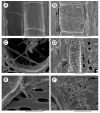Different Responses in Vascular Traits between Dutch Elm Hybrids with a Contrasting Tolerance to Dutch Elm Disease
- PMID: 35330217
- PMCID: PMC8954630
- DOI: 10.3390/jof8030215
Different Responses in Vascular Traits between Dutch Elm Hybrids with a Contrasting Tolerance to Dutch Elm Disease
Abstract
The ascomycetous fungus Ophiostoma novo-ulmi is the causative agent of the current Dutch elm disease (DED) pandemic, which has ravaged many tens of millions of European and North American elm trees. Host responses in vascular traits were studied in two Dutch elm hybrids, 'Groeneveld' and 'Dodoens', which show different vascular architecture in the secondary xylem and possess contrasting tolerances to DED. 'Groeneveld' trees, sensitive to DED, possessed a high number of small earlywood vessels. However, these trees showed a poor response to DED infection for the earlywood vascular characteristics. Following infection, the proportion of least vessels with a vessel lumen area less than 2500 µm2 decreased from 65.4% down to 53.2%. A delayed response in the increasing density of vessels showing a reduced size in the latewood prevented neither the rapid fungal spread nor the massive colonisation of the secondary xylem tissues resulting in the death of the infected trees. 'Dodoens' trees, tolerant to DED, possessed a low number of large earlywood vessels and showed a prominent and fast response to DED infection. Vessel lumen areas of newly formed earlywood vessels were severely reduced together with the vessel size : number ratio. Following infection, the proportion of least vessels with a vessel lumen area less than 2500 µm2 increased from 75.6% up to 92.9%. A trend in the increasing density of vessels showing a reduced size was maintained not only in the latewood that was formed in the year of infection but also in the earlywood that was formed in the consecutive year. The occurrence of fungal hyphae in the earlywood vessels that were formed a year following the infection was severely restricted, as revealed by X-ray micro-computed tomography imaging. Possible reasons responsible for a contrasting survival of 'Groeneveld' and 'Dodoens' trees are discussed.
Keywords: Ophiostoma novo-ulmi; X-ray micro-computed tomography; bordered pits; earlywood vessel; vascular architecture.
Conflict of interest statement
The authors declare no conflict of interest.
Figures



References
-
- Hubbes M. The American elm and Dutch elm disease. For. Chron. 1999;75:265–273. doi: 10.5558/tfc75265-2. - DOI
-
- Mittempergher L., Santini A. The history of elm breeding. Invest. Agrar. Sist. Recur. For. 2004;13:161–177.
-
- Smalley E.B., Guries R.P. Breeding elms for resistance to Dutch elm disease. Annu. Rev. Phytopathol. 1993;31:325–352. doi: 10.1146/annurev.py.31.090193.001545. - DOI
-
- Buiteveld J., Van Der Werf B., Hiemstra J. Comparison of commercial elm cultivars and promising unreleased Dutch clones for resistance to Ophiostoma novo-ulmi. iForest. 2015;8:158–164. doi: 10.3832/ifor1209-008. - DOI
Grants and funding
LinkOut - more resources
Full Text Sources

